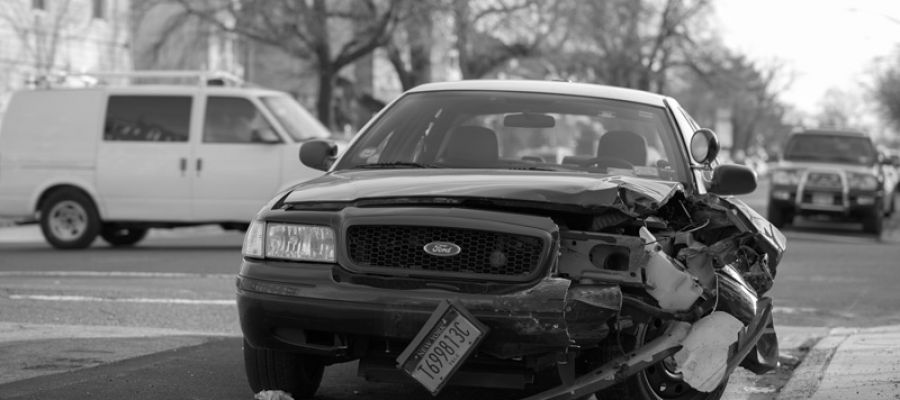How is Fault Determined in an Auto Accident?

Accidents frequently happen on Alberta's roads and highways. If you are involved in a collision, ranging from a fender bender to one where there is serious damage to your car or other vehicles, keep calm and do not voluntarily assume liability or discuss payments.
It will be up to the vehicles' insurers to determine who is at fault. To help them, and to help protect yourself, take photos of the accident scene and the damage incurred by each vehicle. Get any witnesses' names and contact information, and exchange insurance and car registration information with the other drivers, but do not admit guilt. If other parties get belligerent or demanding, tell them they will have to wait until the insurance companies have done their work. If you suspect the other driver is impaired, call 911.
If it seems the combined damage to the vehicles is more than $2,000, you are required in Alberta to attend a police station to file a collision report. If you are unsure of how much the damage is, ask a body shop for an estimate.
POLICE REPORT JUST ONE PART OF THE INVESTIGATION
If the police attend to the accident, they will make a report and may issue traffic violations, but they do not determine who is at fault. Ask the officer at the scene for a copy of their report or its file number. Remember that while the police report is a key piece of evidence used to assess who is at fault, the insurance company makes the final call based on a set of rules.
For their part, police will look at:
- whether there was negligence by one or both drivers;
- whether there was wilful misconduct or disregard for highway safety shown; and
- whether either driver violated a traffic regulation.
The increasing use of cameras on our highways helps police answer these questions and physical evidence such as skid marks.
COMMON 'AT FAULT' ACCIDENT SCENARIOS
When it comes to car accidents, someone is always at fault in the eyes of an insurer. Drivers involved in a single-vehicle crash, such as running into a building or post, will automatically be deemed at fault.
If you collide with another vehicle from behind, you will probably be deemed at fault, as that indicates that you were following too closely or not paying attention. Similarly, if you collide with a vehicle during a lane change, there is a good chance you will be found to be at fault since you disrupted the path of the other vehicle travelling safely in its lane.
If you run a red light or a stop sign and that action causes a collision, it is almost sure you will be the one the insurance company blames.
IN MANY ACCIDENTS, FAULT IS SHARED
Often with accidents, it is not readily apparent who is at fault. Perhaps both drivers share some portion of the blame. Insurance companies rely on "fault determination rules" that cover a wide range of scenarios in those situations. Drawing on those rules can determine how much of the blame rests on your shoulders and what percentage should be attached to the other driver (i.e. 90/10, 80/20, 70/30, 60/40, etc.).
Effective Jan. 1, 2022, the Alberta Government will change the Standard Owner's Automobile Insurance Policy, focusing on Direct Compensation for Property Damage (DCPD) coverage in Alberta. The new regulation details how insurers must determine the degree of fault of the insured, similar to rules in many other Canadian jurisdictions.
DID YOUR NEGLIGENCE CONTRIBUTE TO YOUR INJURIES?
Contributory negligence can be a factor in accidents where your failure to act prudently increases the chance of you being injured, even if the accident was not your fault. For example, suppose you were not wearing a seat belt at the time of the collision. It could be determined that your inaction resulted in you sustaining a greater degree of injury than someone who was belted-in would have incurred in the same situation.
Driver distraction is another major source of negligence in auto accidents. In Alberta, drivers are not allowed to talk on a hand-held cell phone or use it for texting or e-mailing. If you need to enter information into a GPS, pull off the road first. Contributory negligence can also encompass actions such as reading printed material, flossing your teeth, or touching up your makeup as you drive.
The Contributory Negligence Act helps determine what degree of liability and fault you should be apportioned in Alberta. In addition, Alberta's Traffic Safety Act provides some guidance on finding liability while not stripping away common law rights to sue after a motor vehicle accident.
DISPUTING A FAULT DETERMINATION
Any Albertan can dispute an at-fault claim in court if they have compelling evidence showing how the insurance company erred in their evaluation of the accident. The paperwork you receive from your insurer should outline the steps to take if you disagree with their findings.
One option is to retain a mediator, bringing all the parties together and discussing newer evidence. You can also appeal for a more in-depth investigation by the insurer and provide information or evidence that you feel has been overlooked.
AFTER AN ACCIDENT, CONTACT US
A personal injury lawyer can help guide you through your options and help you obtain the compensation you need to help you recover from any injuries. They can also make sure that your insurance company does not attempt to limit the compensation that you are owed. Schedule your Free Consultation by calling 1 (403) 930-8594 or send a message to kantor@kantorllp.ca. We will represent you on a contingency fee basis, so we do not get paid for our time and attention until we settle.
